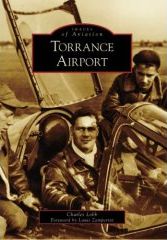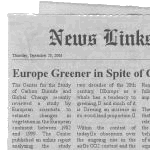 Sunday, Damsel and I attended a book signing in the old Torrance Library, now the Torrance Historical Society Museum, in Downtown Torrance, California. The book we were having signed is Images in Aviation — Torrance Airport written by my long-time friend and former colleague, Chuck Lobb. We enjoyed a nice visit with Chuck and were happy to see him doing well with his book.
Sunday, Damsel and I attended a book signing in the old Torrance Library, now the Torrance Historical Society Museum, in Downtown Torrance, California. The book we were having signed is Images in Aviation — Torrance Airport written by my long-time friend and former colleague, Chuck Lobb. We enjoyed a nice visit with Chuck and were happy to see him doing well with his book.
Image: Chuck holding the book he signed for us. Photo Credit: Damsel
I just started reading the book today, and as a long-time flyer in the Southern California area, I look forward to learning all about the airport’s history.
Amazon link to Torrance Airport book.
Book Description
 Californians were panicked by the Pearl Harbor attack of December 7, 1941, and civilian flights within 200 miles of the coast were immediately terminated. Airfields were commandeered and new ones hastily built. One of these was the Lomita Flight Strip, known today as Zamperini Field, the Torrance Municipal Airport, or TOA. This 490-acre parcel sent four squadrons of P-38 fighter pilots off to war with one commanded by the judge of the Charles Manson trial, an ex-Flying Tiger. Six other pilots became generals, two became commandants of cadets at the Air Force Academy, and one became the only fighter pilot with combat victories in both World War II and the Vietnam War. Japanese Americans returning from World War II internment camps found temporary housing at the field, and the world’s largest manufacturer of civilian helicopters settled there in 1973. The first runway takeoff of a Vertical Take-Off and Landing (VTOL) aircraft was pioneered at TOA, and aerobatic champ Bob Herendeen trained at the site.
Californians were panicked by the Pearl Harbor attack of December 7, 1941, and civilian flights within 200 miles of the coast were immediately terminated. Airfields were commandeered and new ones hastily built. One of these was the Lomita Flight Strip, known today as Zamperini Field, the Torrance Municipal Airport, or TOA. This 490-acre parcel sent four squadrons of P-38 fighter pilots off to war with one commanded by the judge of the Charles Manson trial, an ex-Flying Tiger. Six other pilots became generals, two became commandants of cadets at the Air Force Academy, and one became the only fighter pilot with combat victories in both World War II and the Vietnam War. Japanese Americans returning from World War II internment camps found temporary housing at the field, and the world’s largest manufacturer of civilian helicopters settled there in 1973. The first runway takeoff of a Vertical Take-Off and Landing (VTOL) aircraft was pioneered at TOA, and aerobatic champ Bob Herendeen trained at the site.
About the Author
Charles Lobb is a Federal Aviation Administration certified flight instructor and unofficial historian for Zamperini Field, the Torrance Municipal Airport. Over a 10-year period, he has combed through federal archives and private collections for vintage and compelling photographs, many published here for the first time.
 Here’s a few current news items that sparked our interest:
Here’s a few current news items that sparked our interest:
 Sunday, Damsel and I attended a book signing in the old Torrance Library, now the Torrance Historical Society Museum, in Downtown Torrance, California. The book we were having signed is Images in Aviation — Torrance Airport written by my long-time friend and former colleague, Chuck Lobb. We enjoyed a nice visit with Chuck and were happy to see him doing well with his book.
Sunday, Damsel and I attended a book signing in the old Torrance Library, now the Torrance Historical Society Museum, in Downtown Torrance, California. The book we were having signed is Images in Aviation — Torrance Airport written by my long-time friend and former colleague, Chuck Lobb. We enjoyed a nice visit with Chuck and were happy to see him doing well with his book. Californians were panicked by the Pearl Harbor attack of December 7, 1941, and civilian flights within 200 miles of the coast were immediately terminated. Airfields were commandeered and new ones hastily built. One of these was the Lomita Flight Strip, known today as Zamperini Field, the Torrance Municipal Airport, or TOA. This 490-acre parcel sent four squadrons of P-38 fighter pilots off to war with one commanded by the judge of the Charles Manson trial, an ex-Flying Tiger. Six other pilots became generals, two became commandants of cadets at the Air Force Academy, and one became the only fighter pilot with combat victories in both World War II and the Vietnam War. Japanese Americans returning from World War II internment camps found temporary housing at the field, and the world’s largest manufacturer of civilian helicopters settled there in 1973. The first runway takeoff of a Vertical Take-Off and Landing (VTOL) aircraft was pioneered at TOA, and aerobatic champ Bob Herendeen trained at the site.
Californians were panicked by the Pearl Harbor attack of December 7, 1941, and civilian flights within 200 miles of the coast were immediately terminated. Airfields were commandeered and new ones hastily built. One of these was the Lomita Flight Strip, known today as Zamperini Field, the Torrance Municipal Airport, or TOA. This 490-acre parcel sent four squadrons of P-38 fighter pilots off to war with one commanded by the judge of the Charles Manson trial, an ex-Flying Tiger. Six other pilots became generals, two became commandants of cadets at the Air Force Academy, and one became the only fighter pilot with combat victories in both World War II and the Vietnam War. Japanese Americans returning from World War II internment camps found temporary housing at the field, and the world’s largest manufacturer of civilian helicopters settled there in 1973. The first runway takeoff of a Vertical Take-Off and Landing (VTOL) aircraft was pioneered at TOA, and aerobatic champ Bob Herendeen trained at the site.




 The law that Gov. Arnold Schwarzenegger signed Friday banning motorists in California from holding cell phones while driving does not take effect until July 1, 2008, but the governor is urging drivers to begin complying now.
The law that Gov. Arnold Schwarzenegger signed Friday banning motorists in California from holding cell phones while driving does not take effect until July 1, 2008, but the governor is urging drivers to begin complying now.